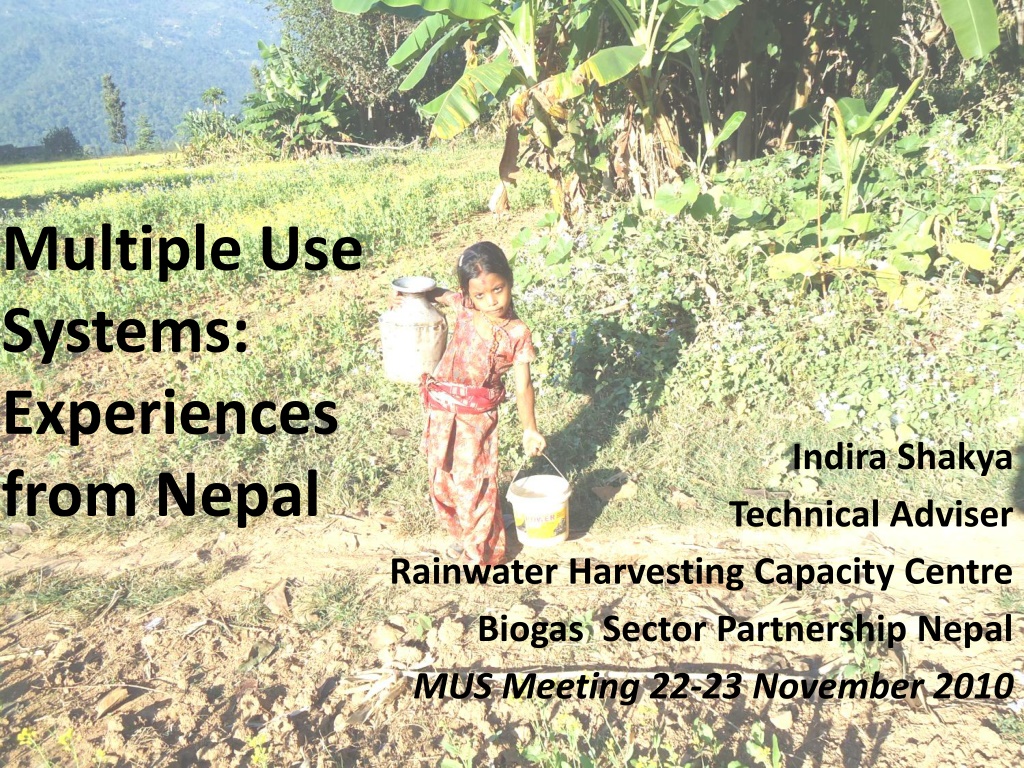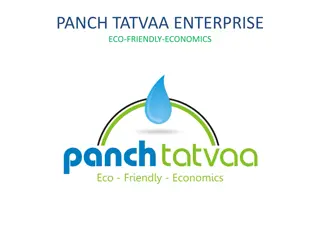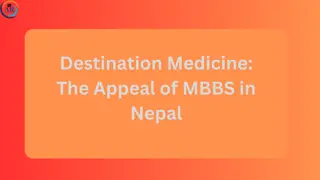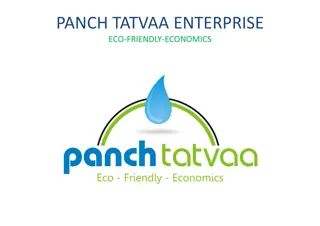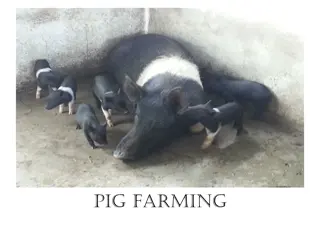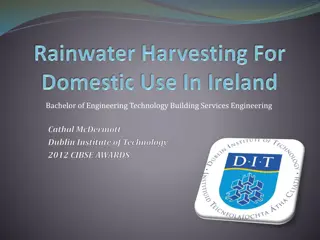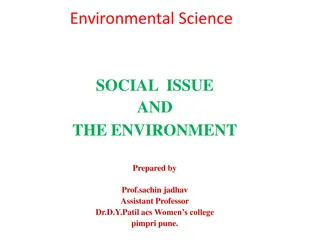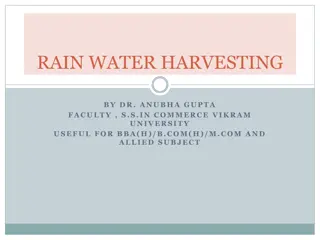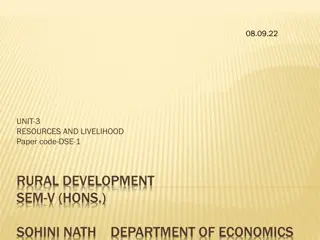Enhancing Rural Livelihood Through Rainwater Harvesting in Nepal
Experience sharing from Nepal on multiple-use systems, focusing on the role of rainwater harvesting in rural areas. The Rainwater Harvesting Capacity Centre (RHCC) advocates for sustainable water solutions, including technologies for drinking, domestic use, biogas operation, kitchen gardens, and livestock. Challenges, impacts, and a way forward are discussed, highlighting the need for rooftop catchment systems and storage options. The RHCC, established in 2006, aims to enhance rural livelihoods through rainwater harvesting interventions.
Download Presentation

Please find below an Image/Link to download the presentation.
The content on the website is provided AS IS for your information and personal use only. It may not be sold, licensed, or shared on other websites without obtaining consent from the author. Download presentation by click this link. If you encounter any issues during the download, it is possible that the publisher has removed the file from their server.
E N D
Presentation Transcript
Multiple Use Systems: Experiences from Nepal Indira Shakya Technical Adviser Rainwater Harvesting Capacity Centre Biogas Sector Partnership Nepal MUS Meeting 22-23 November 2010
Presentation Layout Need for RWHS in Nepal About Rainwater Harvesting Capacity Centre (RHCC) Technologies in Use Stakeholders/Partners Project Process Multiple use of RWHS Impacts Challenges Way Forward
Role of Rainwater Harvesting in Rural Nepal The Water and Poverty Nexus Time consumed in collection of water and fuel wood Small land holdings Dependence on rainfall for agricultural production Involvement of children in household chores
Need is for Rainwater from rooftop catchment Overflow Primary Storage Plastic Secondary Storage lined/compact clay ponds For Drinking and Domestic use, biogas operation For Kitchen Garden For irrigation and livestock, biogas operation
About the RHCC Major Roles of the RHCC Advocacy and Lobby Capacity Building Research and Development Data Management Monitoring and Evaluation Quality Management Promotion and Dissemination Fund Raising Program Area Selection Criteria Distance to exiting sources Absence of any alternatives : boreholes, dugwells Contamination of exiting sources Established in 2006 Objective: To enhance rural livelihood through Rainwater Harvesting intervention
Water Demand used for design purpose Information about the water use (current and future) Drinking Other domestic uses Lives- tock Irrigation Biogas HH com hh hh hh hh Average Water demand per person - dry season. Average water per person - rainy season. Extra water for each activity (average litres per person per day)? 0-1 0-1 1-3 3-10 0-1 3-10 1-3 1-3 10-30 3-10 3-10 10-30 1-3 1-3 10-30 10-30 10-30 10-30
Technical Details Systems used Purpose Capacity Users Cost 1 6.5 m3 Ferrocement Drinking, Micro irrigation Household Rs 9/l 6 20 m3 Brick Masonry Drinking, Micro irrigation, operating biogas Household and community Rs 8.5/l 20 100 m3 Cement Concrete Reinforced systems Drinking Community and Institutions Rs 11/l 1 3m3 One Bag Cement Systems Micro Irrigation Household Rs 3/l 18 72 m3 Plastic Ponds Silpoulin, 150 GSM, IS 14611- 1998 Micro Irrigation, livestock Household Community Rs 0.2 to .75 /l 1 4m3 Plastic Containers Drinking, Micro Irrigation, Household Institutions Rs 15/l
Partnership in the RWH Program For Planning, Financial Support, Policy intervention National and Local Government Organisations Social mobilization, awareness and capacity building Operate, maintenance of system, monitor effectiveness of the system promote the product at local level Non- Government Organisations RWHS Users BSPN-RHCC RWWH Funded by RAIN Foundation For RWHS construction/ Fabrication of accessories and installation; provide after sales service, develop local capacity to take over the task. Private Enterprises Micro Financing Institutes Provision of loan for installation of the system
Crucial Process in the Program Practices, ; Resources and water Needs Identification of community Awareness Building Support in Planning Process and fund Flow Government User Norms,; Local Contribution ; Wealth Ranking; Gender and Ethnicity Issues Local Bodies, Key Informants Form User Groups Micro Financing , Small Credit Groups Site selection; Construction; Operation; Repair Maintenance; Management and After sales service Capacity Building Implementation Users L E G E N D Input Water and Technical Quality; Adherence to Program needs and challenges Stakeholders Activity Elements of focus Local Bodies Program External M&E
Types of MUS systems implemented Upgrading by installing an add-on to an existing system biogas systems operation to meet drinking needs Single- plus , in which a single-use system is designed to meet drinking needs with provision for using overflow for micro irrigation (by default) MUS by design where services are designed for multiple use from the start drinking, operation of biogas systems, micro irrigation, livestock
Use of RWH by Purpose and Frequency, 2009 (No. of HHs) 45 40 35 30 25 20 15 10 5 0 Regularly Up to 3 months Up to 6 months Up to 8 months Occasionally 2 11 2 21 Washing/bathing 1 1 12 5 17 Kitchen gardening: 40 2 6 6 0 Biogas plant operation 0 0 15 10 Cooking
Improving the Technology Improvement in accordance to Changes in User Behaviour
Impacts as experienced by the users Biogas plant performance: Sanitation and health Time Save and its Utilization Education Opportunities Impact upon economic/ income generating Social Impact
The impact of the multi-use water system (MUS) Families no longer have to make difficult journeys to rivers MUS provides families with water for cooking, drinking, washing, feeding livestock and irrigating crops: reducing hazards and saving time upto 3 hours a day People can grow high value crops With more water available for irrigation, many farmers have high nutrition value vegetables for their families as well as grow new vegetables that fetch a high price at market. No more having to choose between drinking and farming With MUS, poor families have no more worries about whether to use the water they have collected for drinking or irrigation? With this new technology there is enough for both.
The impact of the multi-use water system (MUS) Households have access to clean energy Households can also operate the biogas thus eliminating the task of collecting fuelwood and the burden t endure the smoky kitchen which has implications on their health Households also have enough water to meet their hygiene needs Many people in the poorest areas had no water for washing, which often leads to disease. Now, with an MUS pumping water into their communities, families have been able to regain their health and dignity. Women and Children have opportunities for livelihood enhancement Being released from the task of collecting fuelwood and water , time saved provides opportunities for education for the children (girl child in particular) and income generation activities for women
Challenges Cost high cost as compared to conventional water service Outreach difficulties due to terrain and scattered settlement of the community Low priority of the government Low literacy level and awareness amongst the most needy users Lack of awareness amongst the decision makers
Way Forward Private parties involvement for reducing cost of systems and setting up local service centre Continuation of educating/awareness for users on different aspects Multi-sourcing to be promoted specially for non- drinking purposes Income-generating programs to be focused on for enabling higher economic benefits of the systems
